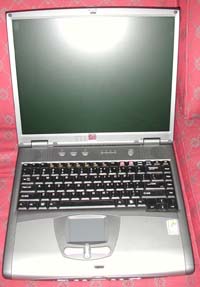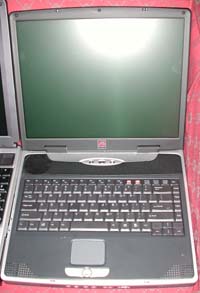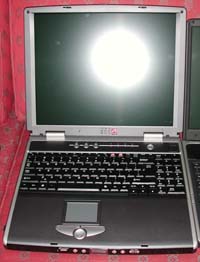
Original Link: https://www.anandtech.com/show/979
ATI Mobility Radeon 9000: Raising the bar again
by Matthew Witheiler on August 29, 2002 5:00 AM EST- Posted in
- Laptops
ATI surprised us all with last month's announcement of the R300 based ATI Radeon 9700 Pro. We had an idea of how the chip would perform and what kind of milestones it would reach, but ATI met and exceeded our expectations. With the R300 core, ATI produced a graphics chip that proved to be above and beyond all the other products on the market.
Amid the fanfare that the Radeon 9700 Pro created it was easy to forget about the second product ATI launched on July 18th. Dubbed the Radeon 9000 Pro, this RV250 based product was to serve as ATI's mainstream video card and replace the Radeon 8500 series cards. Although the Radeon 9700 Pro may have been more exciting to learn about, with all its bells and whistles, the truth of the matter is that the majority of people will find a mainstream video card, like the Radeon 9000, at the heart of their PC.
Because of this, we took a fairly in-depth look at this product as well. Our conclusion: that the Radeon 9000 Pro has what it takes to make it in the cut throat world of sub-$200 video cards. It may not be as impressive as the top of the line 9700 Pro but the 9000 Pro has unique features of its own.
 The
launch of both the Radeon 9700 Pro and the Radeon 9000 Pro cards really showed
that ATI is ready to become not only a, but the, main contender in the video
card market. The fact of the matter is that we would have not been too surprised
if ATI stopped the presses there after launching two impressive desktop parts.
But the company decided to take it one step farther, delivering another blow
to NVIDIA and the like. Today ATI is announcing the 36 million transistor Mobility
Radeon 9000, a chip that promises to bring mobile gaming to places it has never
been before. The chip, code named the M9, is targeted at high-end mobile gaming
systems and looks to be leaps and bounds better than what is out there now in
the mobile market.
The
launch of both the Radeon 9700 Pro and the Radeon 9000 Pro cards really showed
that ATI is ready to become not only a, but the, main contender in the video
card market. The fact of the matter is that we would have not been too surprised
if ATI stopped the presses there after launching two impressive desktop parts.
But the company decided to take it one step farther, delivering another blow
to NVIDIA and the like. Today ATI is announcing the 36 million transistor Mobility
Radeon 9000, a chip that promises to bring mobile gaming to places it has never
been before. The chip, code named the M9, is targeted at high-end mobile gaming
systems and looks to be leaps and bounds better than what is out there now in
the mobile market.
Let's take a look at what makes the Mobility Radeon 9000 so impressive and find out if it completes the one-two-three punch that ATI was hoping to deliver.
Radeon 9000, Take Two
Many of the high performance mobile video parts in the market today are based off of technology initially implemented on the desktop side. Both ATI and NVIDIA have historically taken mid-end desktop graphics chips, thrown in some power saving circuitry, and produced a high-end mobile part. For example, NVIDIA's latest generation mobile chips, the GeForce4 Go series chips, are essentially GeForce4 MX chips. And ATI's Mobility Radeon 7500 chips; they are basically the same as the desktop Radeon 7500. This makes the most sense for the graphics companies, as they are able to use almost the same chip in two different markets: the mainstream desktop market and the high-end mobile market.
We can think of the Mobility Radeon 9000 as the mobile equivalent of the Radeon 9700 in terms of product hierarchy. Both chips are targeted at the high-end range of their applications, both chips bring new and important features to their platforms, and both chips are extremely impressive. On the other hand, in terms of chip design, we can think of the Mobility Radeon 9000 as a Radeon 9000 (RV250) because that is essentially what it is.
The Mobility Radeon 9000 is an RV250 core with power saving circuitry enabled. This gives the mobile chip the same feature set as the Radeon 9000. Let's go over those features again briefly, but please do look at our Radeon 9000 review for even more details on the RV250 GPU.
The RV250 core is actually a new chip design from ATI and is based on a scaled down version of the R200 core that powered the Radeon 8500. In order to decrease manufacturing costs ATI removed one texture unit from each of the R200's pipeline to make the RV250 core. This leaves the RV250 with four pixel pipelines and one texture unit per pipeline, resulting in a much smaller die size. Although important on the desktop market to keep cost down, the small die size of the RV250 has even more advantages in the mobile arena where the small die means a smaller chip package and a less power hungry chip.

The RV250 core powering the Mobility Radeon 9000 actually improved upon the Radeon 8500's R200 core in a number of ways. One of the more tangible improvements that the RV250 holds over the R200 is an upgraded triangle setup engine. This should improve the performance of the chip in situations that are not texel fetch bound. Also added in the RV250 core is support for ATI's FULLSTREAM technology, giving the R200 the ability to run pixel shader programs on video streams. Using FULLSTREAM and supported video playback software (only RealPlayer at time of publication), ATI can smooth out the blocky compression artifacts that are normally seen in low bandwidth video. This is done by running an AA (anti-alising) type program on the incoming stream of a video.
 Video before FULLSTREAM has been applied. |
 Video after FULLSTREAM has been applied. |
ATI also told us that they reworked the internal caches of the chip to make it more efficient but, due to a lack of public documents on the subject, we are unable to figure out exactly what went on.
Since the only thing removed from the R200 core to make the RV250 was a single texture unit from each pixel pipeline, what wasn't added to the RV250 GPU was borrowed from the R200 chip. These borrowed items include the R200's HyperZ II technology, Hydravision support, anisotropic filter, supersampling AA engine, and, most importantly, full DirectX 8.1 support.
The DirectX 8 programmable pixel and vertex shader support is probably the largest advantage that the Mobility Radeon 9000 has over the competition. You may recall that the NVIDIA GeForce4 Go series chips, based off of the GeForce4 MX desktop core, cut costs by taking out all DirectX 8 programmability. This left both the desktop and mobile versions of the NV17 core without the DirectX 8 support that many new games are starting to require. The Mobility Radeon 9000 uses the R200's Charisma Engine II to bring to bring the mobile market the DirectX 8.1 compatibility that it had longed for.
In some instances, such as Unreal Tournament 2003, the pixel and vertex shader support means that games will run smoother (since complex rendering functions are replaced with a more simple vertex and/or pixel shaders). In other instances, the lack of DX 8 functionality means the difference between being able to play a game and not being able to play it. Although there are still a limited number of games that require full DirectX 8 compatibility, support for the API is becoming less of a luxury and more of a requirement a little over a year after its launch.
Longevity of a graphics chip is especially important in the mobile world, where getting a new GPU requires getting a new system. Therefore the inclusion of DirectX 8.1 pixel and vertex shaders is a huge advantage for the Mobility Radeon 9000 as it means that the chip should be able to play the games of today as well as tomorrow. And don't fool yourself: pixel and vertex shaders will soon find their way into OpenGL games as well.
A Few Extras
New to the RV250's mobile core is an upgraded scaler. A scaler is a portion of the graphics chip which is dedicated to taking video and making it fit on the screen. When running an LCD panel at a resolution besides the native resolution of the panel, the scaler takes the image and stretches or shrinks it in order to make it display properly. ATI implemented a new scaler algorithm in the Mobility Radeon 9000 that produces sharper images at nonnative resolutions. Typically, notebook displays become fuzzy when running at a nonnative panel resolution. ATI's new scaler helps alleviate this problem and produces images much cleaner than before when scaling 1.5x or more. So, for example, the new scaler makes the image on UXGA (1600x1200) displays look much better than before when displaying at XGA resolutions (1024x768). This is mainly apparent when viewing text and does not really affect the visual quality of games all that much.
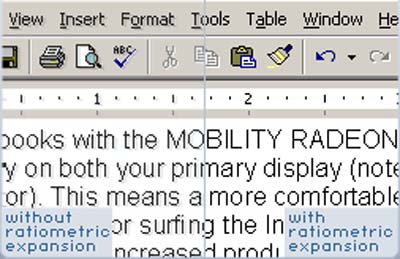
Although difficult to capture with a screen shot, the above is a demonstration
of how ATI's new scaler addresses the problem of running a laptop display at
a nonnative resolution. Note the ghosting and blurry text in the image without
ratiometric expansion.
In order to take full advantage of the new scaler, ATI also introduced a one touch zoom function called ATI ZOOM. This allows for the changing of resolutions with a single key stroke rather than having to change it in the display properties dialogue box.
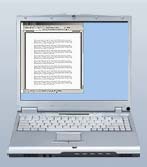 A display at a high resolution. |
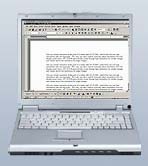 The same display at a lower resolution. |
This feature is really there to help those with limited computer knowledge take advantage of the new scaler in the Mobility Radeon 9000. Not really all that exciting for the typical AnandTech reader but a noteworthy feature nonetheless.

ATI's Zoom keys represented by stickers over the F11 and F12 keys.
POWERPLAY
![]() The
Mobility Radeon 9000 introduces the third generation of ATI's power management
technology. Coined POWERPLAY, the hybrid hardware/software power saving techniques
attempt to keep the power consumption of the Mobility Radeon 9000 as low as
possible.
The
Mobility Radeon 9000 introduces the third generation of ATI's power management
technology. Coined POWERPLAY, the hybrid hardware/software power saving techniques
attempt to keep the power consumption of the Mobility Radeon 9000 as low as
possible.
Hardware wise it seems that ATI did not change the fundamentals of POWERPLAY much. The technology still consists of three main features: clock gating, clock and voltage throttling, and LCD refresh rate modulation. These are all features shared by the NVIDIA GeForce4 Go series chips as well.
Clock gating gives the GPU the ability to turn off and on various portions, or blocks, of the chip depending on if they are needed or not. The logic of the chip is organized in such a way that if a specific feature of the chip is not needed it can be turned off. For example, if a given laptop is only displaying items in a 2D environment on the laptop's LCD panel, only the LVDS and the 2D engine need to be powered. The other components on the chip, like the 3D engine, the TMDS, and the MPEG-2 decode functions can be turned off. We learned that the RV250 core is highly segmented when it comes to clock gating as demonstrated by the fact that even the pixel and/or vertex shader engines can be turned off when not being used.
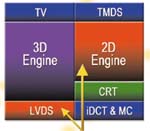
Clock gating, where only the needed potions of the chip are powered.
The Mobility Radeon 9000 can also vary its core speed, memory clock speed, and voltage depending on the situation that the chip encounters. ATI calls this feature "Power on Demand" and in the case of the Mobility Radeon 9000 it gives the chip the ability to clock itself at a low clock speed and voltage when the chip in an idle or low demand state. The chip runs in this power saving mode the majority of the time when the system is in a static environment. Such a situation leaves the Mobility Radeon 9000 chip running at a 80MHz core speed and a 80MHz memory speed at 1.25 volts while still maintaining the ability to drive a panel running at 1600x1200x32.
The final hardware implementation of POWERPLAY involves the laptop's LCD display. The LCD panels found on laptops are actually the most power hungry part of mobile computers, consuming a good amount of the system's battery power. To help decrease the amount of power that the LCD draws, the Mobility Radeon 9000 lowers the refresh rate on the LCD display while on battery power.
These power saving features resulted in a product that is, at most, only 10% more power hungry than its predecessor at the highest performance settings.
POWERPLAY (continued)
Actual hardware is only one portion of ATI's POWERPLAY technology. The software employed by POWERPLAY is completely new for the third implementation of the technology and is leaps and bounds more robust than competing power management software.
When it comes to mobile GPU power management, we are used to seeing a single slider bar that controls the speed and perhaps voltage of the GPU. The settings altered on the slider typically only went into effect when the system was on battery power, leaving the video chip running at full speed the entire time it is given AC power and at the lesser, user defined maximum clock speed when ever the unit is on battery power. Although this method does get the job done, it is a somewhat brutish way of ensuring the desired battery performance of the notebook. ATI's new POWERPLAY software includes much more finesse.
Rather than keep the GPU performing at one set, user definable, maximum speed while on battery, ATI came up with a different approach. ATI's new POWERPLAY software allows the chip to dynamically clock itself at up to three different positions at two different points depending on battery life. For example, you could set a notebook with the Mobility Radeon 9000 to run the GPU at full clock speed and voltage when battery life is anywhere from 40% to 100% but at a one of two lower clock speeds when the battery life falls below this threshold. Since the low battery threshold is fully user customizable the chip can go to a lower speed at anywhere from 99% to 1% of battery life remaining.
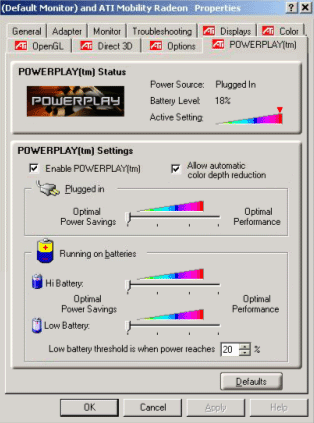
The POWERPLAY software utility.
The user can also set the performance/power balance while on AC power but it clearly makes sense to leave this slider at optimal performance while plugged in.
Another feature that the new POWERPLAY driver tab offers is automatic color depth reduction. Decreasing color depth from 32-bit color to 16-bit color actually saves a small amount of power since the graphics chip has less information it needs to process. The automatic color depth reduction on the Mobility Radeon 9000 automatically reduces the color depth from 32-bit color to 16-bit color while on battery power. This results in a small decrease in power consumption for the chip but when it comes to power, any bit saved results in greater battery life.
We were very pleased to find such a powerful and easy to use user accessible implementation of POWERPLAY. The integration with the established driver base turned out great and settings are easy to find and adjust. In fact, the only problem with the software portion of POWERPLAY is not actually caused by ATI but rather by notebook manufacturers.
In the past we have seen very few notebook OEMs willing to implement driver based power management functions. Both the older Mobility Radeon 7500 and the current GeForce4 Go series chips include similar, although more basic, power management tools. Only a limited number of notebooks shipping with these chips actually implement the user controlled features of their power savings technology. Adoption rate for the user controlled power features is fairly low due in a large part to OEMs concerns with supporting yet another notebook feature. The last thing that a company like Dell, Compaq, or HP wants are users calling the support line because of a problem resulting from a user selectable slider
None of the notebooks that were unveiled at the launch event implemented the software portion of POWERPLAY. ATI assures us that we will see notebooks on the market that include this part of POWERPLAY. They stressed that the software implementation of POWERPLAY will come later in the product's cycle, as adding the software requires additional qualification to the production of a notebook. The notebooks launching today and in the next few months will likely not have the feature enabled, but come the end of the year ATI claims that we should see full implementations of POWERPLAY on the market. This puts the full implementation POWERPLAY technology around the time that Intel's new Banias processor hits the streets. We have to remain skeptical as we were assured the same thing with the Mobility Radeon 7500 and the NVIDIA GeForce4 Go chips as well.
Due to time constraints and testing limitations, we were unable to investigate how much of an impact POWERPLAY has on battery consumption. We hope to do a more in-depth article covering this topic in the coming weeks.
The Chip(s)
There are actually going to be five versions of the Mobility Radeon 9000 floating around out there. All are based on the RV250 core but distinguish themselves in terms of configuration, clock speed, and memory bus width.
In order to minimize the requirements for the Mobility Radeon 9000, ATI decided to create a memory on chip solution, producing one of the three different packaging variations of the chip. The memory on chip solution implemented by ATI is essentially the same as the memory on chip method that was introduced with the GeForce4 Go chips with their Mobile AGP Package (MAP) design.
Finding space and making traces for external video memory is not an easy task in the cramped confides of a notebook. Previously, video processor manufacturers dealt with these problems by including on die memory. This served to lessen the headaches encountered when dealing with external memory solutions but introduced new problems into the actual chip production.
Due to size constraints there is only a limited amount of video memory that can be integrated onto a chip's die. Even a fairly small amount of integrated memory creates a large die that results in higher chip prices and higher failure rates. It is for this reason that mobile graphics chips with on die memory are typically only used in specific mobile systems where space is at the largest premium and fast 3D performance is not necessary (as the chips are usually limited to, at most, 16MB of on die memory).
The solution to this problem that both ATI and NVIDIA have come to was only made possible recently with the release of BGA memory. Thanks to BGA memory's small package size, on chip memory solutions have become not only possible but fairly easy to create. The process involves mounting the GPU and the BGA memory on the same substrate, with the GPU core going on the bottom and the memory going on the top.
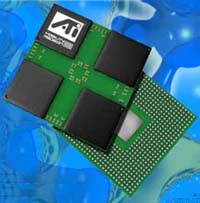
The memory on chip Mobility Radeon 9000.
The Mobility Radeon 9000 comes in two on chip memory configurations. The first is the high-end 64MB solution that includes 64MB of memory connected to the GPU via a 128-bit DDR memory bus. This chip is called the Mobility Radeon 9000 S64. The second is a lower-end solution that includes 32MB of on chip memory but only has a 64-bit DDR memory bus. This variation is called the Mobility Radeon 9000 E32. Like any video chip that includes a 64-bit DDR memory bus, we can except performance of the 32MB on chip Mobility Radeon 9000 to be a good amount lower than the 64MB on chip version. The naming convention denotes the memory bus width (S for 128-bit, E for 64-bit) followed by the video memory size (64 for 64MB, 32 for 32MB).
The memory on chip Mobility Radeon 9000 will likely find its way into thin and light notebooks. Next year ATI predicts that we will see a Mobility Radeon 9000 S64 running in a thin and light notebook with a Banias processor under the hood. If this proves to be the case, mobile gaming will enter a place it has never been before: in the thin and light segment.
With ATI's announcement that memory on chip Mobility Radeon 9000's will be shipping in notebooks next week, the company seems to be the first to actually be shipping an integrated memory video product for the mobile market. This is because NVIDIA's MAP chips have yet to find their way into shipping notebooks as far as we can tell.
The Mobility Radeon 9000 also comes in a discrete chip package like the ones found on desktop video cards. This chip has the same features as the Mobility Radeon 9000 with on chip memory and is available with both a 128-bit and a 64-bit DDR memory bus. The discrete Mobility Radeon 9000 will likely find its way into high-end, high weight desktop replacement notebooks where the space savings offered by the on chip memory does not make up for the higher price.
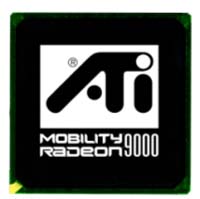
The discrete Mobility Radeon 9000.
The Chip(s) (continued)
The integrated memory Mobility Radeon 9000 and the discrete Mobility Radeon 9000 are not the only two versions of the chip. With the Mobility Radeon 9000 ATI expands its product line to include the first video chip designed specifically for desknote computers.
We first got wind of the desknote computer configuration three months ago when we took a look at the ECS i-Buddie 4. It was then that we initially expressed our excitement over the concept of having a desktop machine in the amount of space normally reserved for laptops. In fact, the largest complaint we have had about desknote systems is the graphics solutions that they employ; usually low-end integrated graphics chips. We initially suggested that perhaps an nForce chipset would make for a good desknote solution, but clearly a high-end discrete graphics chip would be even better. Unfortunately, desktop graphics chips were not designed to work well in the confides of a notebook system and mobile graphics chips were not designed to work without batteries.
The desknote variant of the Mobility Radeon 9000 addresses these problems. Although the chip is not physically different than the discrete Mobility Radeon 9000 that will soon be found in notebooks, it runs at a higher clock speed. ATI is able to clock the desknote Mobility Radeon 9000 at higher speeds because the thermal requirements of a desknote system are not as stringent. Plus the company did not need to worry about what a high clock speed will do a notebook's battery life.
ATI is no fool for jumping onto the desknote bandwagon. The concept has been met with wide praise from users, who pay less for a portable system, to OEMs, who make larger profits by using desktop parts. Just ask ECS, a motherboard company who turned the idea of a desknote system into what has become their most profitable product. People are buying these systems and if ATI has its way we will find the Mobility Radeon 9000 at the heart of many desknote computers.
The final version of the Mobility Radeon 9000 will be a workstation variant of the chip. Like the desknote version of the Mobility Radeon 9000, this chip will not be physically different than the Mobility Radeon 9000 but will ship with a new OpenGL driver for workstation class machines; drivers developed by the FireGL team.
All the chips are actually pin compatible with one another and the older Mobility Radeon 7500, as they are all made in a 31x31 BGA package. Thanks to this, ATI has a unique vision of the future. What they see is one mobile motherboard design being used in everything from the value segment to the high-end segment. Ideally for ATI, a manufacturer will produce one design that accepts the Radeon IGP north and south bridges as well as includes space for the Mobility Radeon 7500 and the Mobility Radeon 9000. The value segment notebook would use this motherboard and include Radeon IGP and only the Radeon IGP in the system. The main stream notebooks would include the Radeon IGP as a chipset solution and a discrete Mobility Radeon 7500 as a video solution. Finally, the high-end notebook would consist of the Radeon IGP chipset and a separate Mobility Radeon 9000 graphics chip.

FLEXFIT: ATI's strategy for notebook domination.
Of course, one of the first questions we asked upon first hearing about the Mobility Radeon 9000 is what clock speed the various versions of the chip will be running at. It seems that the maximum speeds that the Mobility Radeon 9000 for notebooks will support is 250MHz in the core and 230MHz for the memory. This places the highest clocked Mobility Radeon 9000 at a clock speed slightly lower than the desktop Radeon 9000 Pro's speed of 270/275MHz but higher than the standard Radeon 9000 speed of 250/200MHz.
Since it is up to OEM designers to decide exactly how fast they clock their specific Mobility Radeon 9000 solution it is likely that we will see some notebooks using chips clocked below the 250/230MHz limit. There is also a limitation that keeps the memory on chip Mobility Radeon 9000 from running memory clock speeds equal to those of the discrete memory parts. It is likely that the memory on chip Mobility Radeon 9000 chips will be clocked at around 250/200MHz or 250/220MHz in most instances. NVIDIA had a similar clock limitation with their MAP chips which ran at clock speeds slower than the discrete parts. At a 220MHz memory bus frequency, the performance of the memory on chip Mobility Radeon 9000 should not be much lower than the performance of a discrete part running a 230MHz memory clock.
The desknote Mobility Radeon 9000 is able to be clocked much higher for the reasons previously mentioned. This means that the desknote variant of the Mobility Radeon 9000 will be able to run at 270/270MHz, putting it at essentially the same speed as the desktop Radeon 9000 Pro.
The Contenders
The Mobility Radeon 9000 marks a lot of firsts. Not only is the Mobility Radeon 9000 the first mobile video chip to offer DirectX 8.1 pixel and vertex shaders, it is the first time that a high-end mobile video chip will be available in laptop computers at the same time as the chip's launch.
ATI has a large number of launch partners for the Mobility Radeon 9000 including ECS, FIC, and Alienware. We got a sneak peak at what the future of mobile gaming will look like when ATI presented us with a number of systems that made use of the Mobility Radeon 9000, all of which will be shipping within the next month or so.
The first notebook to market will be an FIC designed notebook that will likely find itself rebadged and sold under a variety of names. This notebook will actually be shipping in the states starting next week.
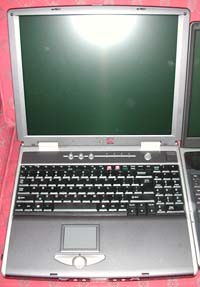
FIC Mobility Radeon 9000 system. Click here to Enlarge
ATI also displayed three other soon to be shipping notebooks that were Mobility Radeon 9000 based in addition to the FIC system.
We also got wind of the fact that a good number of tier one OEMs will be shipping Mobility Radeon 9000 notebooks soon. The validation and verification time for these historically cautious OEMs is much longer than the tier two and tier three vendors but even so designs are near finalization. One thing we did learn: Compaq/HP will be producing a Presario 2800 notebook that makes use of the Mobility Radeon 9000. ATI tells us that we should see these notebooks shipping in about 3 weeks. Judging by what we saw in our Mobility Radeon 7500 based Presario 2800, the Mobility Radeon 9000 version of the notebook should be very impressive.
It is exciting to see Mobility Radeon 9000 based notebooks come to market as soon as they are. Past mobile GPU launches have proven that it can be months before a new notebook design is ready to go. Hopefully the Mobility Radeon 9000 launch will set precedent for future mobile GPUs.
The Test
We were lucky enough to get two identical machines to compare the Mobility Radeon 9000 head to head against the GeForce4 440 Go. Due to NDAs, our hands are rather tied when describing the details of the machine tested but the below table gives you an idea of the basics of the system we were testing on.
|
|
Windows
XP Professional Test System
|
|
|
Hardware
|
|
Notebook
System
|
|
| CPU(s) |
Mobile
Pentium 4-M 2.0GHz
|
| Motherboard(s) |
845MP
DDR
|
| Memory |
512MB
PC2100
|
| Hard Drive |
40GB
|
| CDROM |
DVD/CDRW
|
| Video Card(s) |
ATI
Mobility Radeon 9000 64MB 128-bit DDR
NVIDIA GeForce4 440 Go 64MB 128-bit DDR |
| Ethernet |
Onboard Ethernet Adapter
|
|
|
Software
|
|
Operating System |
Windows XP Professional |
| Video Drivers |
ATI
7.75
NVIDIA 28.35 |
|
|
Benchmarking Applications
|
|
Croteam
Serious Sam 2: The Second Encounter - Extreme Settings |
Unreal Tournament 2003
We recently switched to a newer build of Unreal Tournament 2003 (created on 8/6/02). This benchmark should give you a good idea of how a system will perform in a number of Unreal Tournament 2003 levels. We chose to run our benchmarks at three resolutions (800x600, 1024x786, and 1280x1024) because these are the resolutions at which most mobile gamers will play current and upcoming titles.
|
Antalus, an outdoor level in Unreal Tournament 2003, is one of the more stressful levels that the game has to offer. Already at 800x600x32 with high detail settings enabled, we see that the Mobility Radeon 9000 is able to provide a noticeable performance lead over the GeForce4 440 Go. Here the Mobility Radeon 9000 performed 12% faster than the fastest performing NVIDIA mobile part.
|
As we bump the resolution up, the performance advantage offered by the Mobility Radeon 9000 shrinks to 8%.
|
Here the performance advantage of the Mobility Radeon 9000 drops to just 7%. Is this a trend that will continue or a specific situation where the Mobility Radeon 9000 is not able to perform at its best?
|
Well, switching levels answered that question fairly quickly. Although in the Antalus demo the maximum performance increase offered by the Mobility Radeon 9000 was 12%, in the Asbestos level at 800x600x32 we already see the Mobility Radeon 9000 outdoing the GeForce4 440 Go by 27%. It seems that the Antalus demo does not show off the Mobility Radeon 9000's strongest points, likely due to the way that the level is rendered.
It is interesting to note that on the high-end desktop side we usually find the Asbestos demo to be fairly CPU bound especially at a low resolution like 800x600x32. Clearly the GeForce4 440 Go does not give the system enough video processing power to allow the CPU to become the bottleneck.
|
At 1024x768x32 the Mobility Radeon 9000 excels again. Here the chip outperformed the GeForce4 440 Go by a noticeable 25%.
|
Finally, at 1280x1024x32, we see that the Mobility Radeon 9000 is able to keep up the trend. The Mobility Radeon 9000 runs 25% faster than the GeForce4 440 Go not only in this resolution but on average throughout the whole Asbestos demo.
Unreal Tournament 2003 (continued)
The ctf-citadel demo is a capture the flag gameplay benchmark set in the Citadel level.
|
The Mobility Radeon 9000 only outperforms the GeForce4 440 Go by 5% at 800x600x32 in the Citadel level. The reason: the benchmark is fairly well CPU limited at this resolution.
|
Cranking the resolution up gives us a bit more performance improvement, 8% as opposed to 5%, but we still would have liked to see more. Again, we can hypothesize that the one texture per pipeline or perhaps the fact that the Citadel level does not make extensive use of shaders is holding the Mobility Radeon 9000 back.
|
Stepping the resolution up one more level increases the advantage that the Mobility Radeon 9000, this time amounting to 11%.
The br-endagra demo tests the performance of the card in the bombing run gameplay mode.
|
So much for those mediocre performance increases that we saw in the Citadel and Antalus demos. In the Endagra demo, the Mobility Radeon 9000 performs 24% faster than the GeForce4 440 Go, likely due to increased shader functions.
|
The performance delta widens as the resolution of the Endagra demo is increased to 1024x768x32. Now we are seeing the Mobility Radeon 9000 offer a 26% speed boost.
|
In the same demo at 1280x1024x32 the Mobility Radeon 9000 brings to the table the largest performance advantage it has enjoyed as of yet at 27%.
Unreal Tournament 2003 (continued)
The dm-inferno benchmarks takes the crown as the most stressful in level in our set of Unreal Tournament 2003 tests.
|
The Mobility Radeon 9000 is able to keep up the trend established in many of the other Unreal Tournament 2003 levels by performing 22% faster than the GeForce4 440 Go in this instance.
|
The performance advantage drops to 14% when going to 1024x768x32. Impressive still, but not as large of a speed increase as we have seen in other Unreal Tournament 2003 demos.
|
7% faster than the GeForce4 440 Go in the Inferno death match at 1280x1024x32
|
Interestingly enough, we see the Mobility Radeon 9000 pick up speed again at 800x600x32 in the Suntemple demo, going 25% faster than the NVIDIA product.
|
When the resolution of the Suntemple demo is increased, the Mobility Radeon 9000 still finds itself with a very comfortable lead of 24%.
|
At the final resolution we tested the Suntemple demo at the Mobility Radeon 9000 holds its ground with a 23% lead.
Serious Sam 2
|
|
|
The Serious Sam 2: Little Trouble benchmark proved to output some interesting results. Similar to the situation encountered in the Antalus and Citadel Unreal Tournament 2003 demo, the Mobility Radeon 9000 out performed the GeForce4 440 Go anywhere from 4% to 8%. Given the fact that we saw performance increases of around 25% in many instances in Unreal Tournament 2003 and the fact that the Jedi Knight 2 performance of the card was substantially better, we really can't understand why the Serious Sam 2 performance does not mirror our other results. We suspect that it could be a driver problem specific to the system we were using (which is a notebook that is not yet ready for mass production). It could also be with the way that Serious Sam is rendering the game with the extreme quality settings. Hopefully future testing of the product will yield the answer.
Jedi Knight 2
|
|
|
Jedi Knight 2 really takes advantage of the power provided to it by the Mobility Radeon 9000. It is clear that this typically CPU limited benchmark was not running at its full potential on the GeForce4 440 Go. Our Jedi Knight 2 tests show the Mobility Radeon 9000 going 8% faster than the flagship mobile NVIDIA chip at 800x600x32, 17% at 1024x768x32, and 27% faster at 1280x1024x32. Impressive gains, especially on a mobile platform.
Conclusion
ATI is really pushing the envelope on video cards with the announcement of the Mobility Radeon 9000. Not only does the chip bring to market some needed speed and features, it is also available in notebook systems as of today. Both of these aspects of the Mobility Radeon 9000 make it the mobile graphics chip of choice today as well as the foreseeable future. Let's go over a bit of what we learned.
First off, in many gaming situations the Mobility Radeon 9000 is able to offer substantial performance increases over the GeForce4 440 Go, on the order of around 20-25%. In others benchmarks, like two specific levels in Unreal Tournament 2002 and in at least one level of Serious Sam 2, the performance increase is not so pronounced (5-10%). The times that the performance difference is pronounced can mean the difference between playing a game smooth or choppy at a high resolution. The times when the performance difference is not as large, you are still left with the highest performing mobile GPU available, although by a fairly trivial amount.
Secondly, the largest advantage that the Mobility Radeon 9000 has over its competitors is its DirectX 8.1 compatibility. The introduction of pixel and vertex shaders is a huge step forward for the mobile community and further closes the gap between desktops and notebooks. DirectX 8 compatibility is necessary if you wish to play the games of tomorrow and since a laptop video chip can't just be swapped out for a new one, getting the best mobile GPU on the market at the time of purchase is very important if you like your 3D games.
We are not the only ones who were impressed with the functionality and speed that the Mobility Radeon 9000 offers. John Carmack of iD Software echoed our sentiments in comments that he made for the Mobility Radeon 9000 launch. The brains behind Quake III and Doom 3, Carmack had the following to say about the Mobility Radeon 9000:
"The M9 laptop part allows state of the art high end game development to be accomplished on a laptop platform for the first time really since we've moved to hardware acceleration."
If that ringing endorsement doesn't whet your appetite, try another thing Carmack said on for size:
"You know, on our current work at Id right now we're still pushing really hard to make Doom run well on various high end desk top cards. So it's pretty startling to be able to fire it up on a laptop and see it run at a really pretty startling good pace."
That's right. Carmack stated that Doom 3 will be able to run smoothly on a mobile platform powered by a Mobility Radeon 9000. A next generation, highly intensive game able to run on a laptop. Why can the Mobility Radeon 9000 succeed where other mobile chips are sure to fail? It is because of the pixel and vertex shaders incorporated into the chip as well as the fast 4 pixel pipeline that it employs.
Obviously the Mobility Radeon 9000 does not exist in a vacuum; there are always competing chips on the horizon that threaten to dethrone the current king. First off there is Trident's latest addition to the video chip market, the XP4, which will undoubtedly find its way into the mobile market. The problem is that we do not know how far off the mobile XP4 is or exactly what the performance of the chip will be. Then there is NVIDIA's next generation mobile chip likely based off of the NV31 core. Details on the NV31 are even more scarce than details on the NV30 so we don't really know what or when to expect NVIDIA's next mobile part.
However, with Carmack's words and our benchmarks you should feel confident that a Mobility Radeon 9000 powered mobile system will be able to handle the games of today (Jedi Knight 2/Serious Sam 2), the near future (Unreal Tournament 2003), and the far future (Doom 3) which marks the first time we have been able to make such a statement about a mobile chip.

